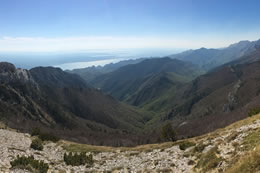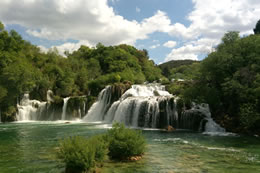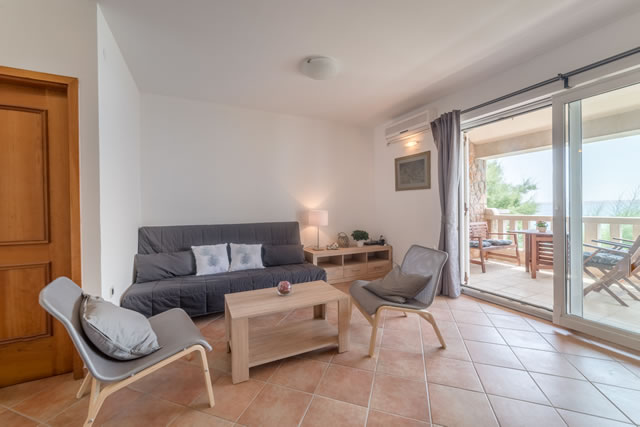National park Paklenica
Due to its unique natural features, magnificent forests and extraordinary geomorphologic structures, the area of Velika and Mala Paklenica was proclaimed a national park in 1949. The main reason for proclaiming this area a national park was the protection of the largest and best preserved forest complex in the territory of Dalmatia, which was threatened by overexploitation. The Paklenica National Park stretches on the area of 95 km2 , on the littoral slope of South Velebit under the zone of highest mountain peaks Vaganski vrh (1752) and Sveto brdo (1753).
It covers the area of torrent flows of Velika Paklenica and Mala Paklenica, and their distinctive canyons carved vertically into the south slopes of Velebit and the broader surrounding area. The relatively small area has an abundance of geomorphological phenomena and forms, diverse flora and fauna, attractive landscapes and intact nature. Diverse habitats in the area of Paklenica, along with elevation stratification, provide a home for diverse fauna.
Distinctive features of Paklenica National Park are autochthonous forests of black pine, several types of beech forests and deep canyons with torrent flows of Velika and Mala Paklenica. Wider area of Paklenica National Park prides itself with rich and diverse cultural heritage.
Visit National park Paklenica official pageThe Northern Velebit National park

Established in 1999, Northern Velebit is the youngest of eight national parks in Croatia. This part of the Velebit Mountain is a true patchwork of the most diverse habitats that are home to countless plant, fungus and animal species – a wealth that is yet to be explored in its entirety. It is this diversity of kart formations, wildlife and landscape, to a large extent created by man, which was the main reason for setting up the Northern Velebit National Park.
Northern Velebit National Park encompasses several areas protected earlier: Hajdučki i Rožanski Kukovi, strict reserve, the Visibaba botanical reserve – home to the endemic species Croatian sibirea, and the Zavižan-Balinovac-Velika kosa botanical reserve which houses the well-known Velebit Botanical Garden, which has been listed as a monument of landscape architecture.
Due to its exceptional worth the Northern Velebit National Park has been included in the National Ecological Network and is listed in the proposal of the future Natura 2000 network of protected areas.
Visit The Northern Velebit National park official pageNational park Krka

Krka National Park lies within Šibenik-Knin County, and covers a total area of 109 km² of the loveliest sections of the Krka River, and the lower course of the Čikola River.
The national park is a vast and primarily unaltered area of exceptional natural value, including one or more preserved or insignificantly altered ecosystems. The purpose of the park is primarily to serve science, culture, education and recreation, while tourism activities have also been introduced for its visitors.
Including the submerged part of the river at the mouth, the Krka River is 72.5 km long, making it the 22nd longest river in Croatia. It springs in the foothills of the Dinara mountain range, 2.5 km northeast of Knin. With its seven waterfalls and a total drop in altitude of 242 m, the Krka is a natural and karst phenomenon. The travertine waterfalls of the Krka River are the fundamental phenomenon of this river.
Visit National park Krka official pageNational park Kornati

The Irish writer George Bernard Shaw described this magical archipelago in the Middle Adriatic with the following words: „On the last day of Creation God desired to crown His work, and thus created the Kornati islands out of tears, stars and breath.“. This is the most indented group of islands in the European Mediterranean of the most exceptional landscape value which was given the status of national park in 1980.
More than three quarters of the Park’s surface belong to the sea, whereas the land part consists of 89 islands, islets and reefs in the total surface of 50 km2.
The two groups of islands in the Park, Kornatski and Pučinski set of islands, are equally beautiful and interesting, however the islands of Pučinski set with their „crowns“ (crags or cliffs) are the most valuable ones. The highest peak in the National Park is Metlina located on the longest island of Kornat which also holds the 34 meter long cave in the Stiniva Cove.
Visit National park Kornati official pageNational park Plitvice lakes

Plitvice Lakes is the oldest and largest national park in the Republic of Croatia. The park is situated in the mountainous region of Croatia, between the Mala Kapela mountain range in the west and northwest, and the Lička Plješivica mountain range to the southeast. Administratively, the park falls within two counties: Lika-Senj (90.7%) and Karlovac (9.3%).
With its exceptional natural beauty, this area has always attracted nature lovers, and already on 8 April 1949, it was proclaimed Croatia’s first national park. The process of tufa formation, which results in the building of the tufa, or travertine, barriers and resulted in the creation of the lakes, is the outstanding universal value, for which the Plitvice Lakes were internationally recognised on 26 October 1979 with their inscription onto the UNESCO World Heritage List. In 1997, the boundaries of the national park were expanded, and today it covers an area just under 300 km2.
The park is primarily covered in forest vegetation, with smaller areas under grasslands. The most attractive part of the park – the lakes – cover just under 1% of the total park area.
Visit National park Plitvice lakes official page






















